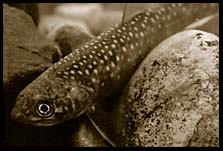by Sherry Devlin, the Missoulian
Attorney says government has not followed guidelines in the Endangered Species Act
Two environmental groups that pushed — for seven years — for the federal government to protect bull trout as a threatened species filed suit Monday to force protection of the big fish’s habitat as well.
 The U.S. Fish and Wildlife Service has missed three deadlines for designating critical habitat for bull trout – despite the species’ continued fragmentation and isolation, said the lawsuit filed in U.S. District Court in Portland, Ore.
The U.S. Fish and Wildlife Service has missed three deadlines for designating critical habitat for bull trout – despite the species’ continued fragmentation and isolation, said the lawsuit filed in U.S. District Court in Portland, Ore.
“It’s what we call a black-letter law,” said Jack Tuholske, the Missoula attorney representing Alliance for the Wild Rockies and Friends of the Wild Swan in the lawsuit. “The Endangered Species Act requires the government to designate critical habitat at the time a species is listed, or to conduct additional necessary research and issue the designation within one year of the listing.”
The government listed the Columbia and Klamath river populations of bull trout as threatened on June 10, 1998. Bull trout in the Jarbidge River basin were listed on April 8, 1999, then in the Coastal-Puget Sound and St. Mary-Belly River drainages on Nov. 1, 1999. All bull trout in the lower 48 states are now protected under the Endangered Species Act.
But none of the habitat needed for their conservation has been so designated, Tuholske said, and bull trout are worse off for the government’s malaise.
“The public often wonders why species never get off the endangered species list,” said Mike Bader, executive director of the Alliance for the Wild Rockies. “But the government won’t take the first and most essential step toward recovery: designating critical habitat. We are still arguing about critical grizzly bear habitat, and it’s been 25 years. We really don’t want to repeat that scenario with bull trout.”
“The problem that we’re seeing,” Bader said, “is that a lot of key bull trout habitat is slipping through the cracks. They’re continuing to lose habitat, and populations are getting even more fragmented and isolated. We feel an identification and designation of critical habitat will bring the big picture into focus — and onto recovering bull trout not just in their current habitat, but in their historic range as well.”
Bull trout have disappeared from half of their historic range; they are native to Washington, Oregon, Idaho, California, Montana, Nevada, Alaska, Alberta and British Columbia. And they are extinct in California.
Tuholske said Section Four of the Endangered Species Act instructs the Fish and Wildlife Service to designate the habitat essential to a listed species’ protection and recovery. Once designated, habitat cannot be adversely affected by actions of federal agencies.
Fish and Wildlife Service personnel had not seen the lawsuit by late Monday afternoon, so could not comment on its specifics. But Lori Nordstrom, a biologist in the agency’s Helena office, said there simply is no money for the work.
“Congress allocates our budget, and we cannot take money from one program and give it to another,” she said. “Right now, our whole budget is designated for developing critical habitat for other species. Bull trout is not one of the species.”
However, Nordstrom said, she does not believe bull trout are suffering because of the tardy designation.
“For most species, the designation of critical habitat is not an added benefit,” she said. “We don’t designate a preserve or something like that. And we don’t draw circles around people’s land. It only affects activities being undertaken by federal agencies, which is something we already review.”
“Personally,” Nordstrom said, “I think it is better to spend money reviewing species to see if they need the protection of the act at all, especially given the reality of limited money.”
The Fish and Wildlife Service is working on a recovery plan for bull trout, she said. And considerable ongoing species and habitat restoration work is being done in Montana. “There are lots and lots of things going on that are to the benefit of bull trout, and that are a result of the listing.”
Lack of money is no excuse, countered Tuholske. “The service has tried a similar excuse in federal court in other jurisdictions with other species, and the courts have not bought into those excuses. The Endangered Species Act is clear on its face. The Fish and Wildlife Service is not at liberty to proceed in a manner that it may find more convenient. It must designate the critical habitat of listed species.”
It was, however, necessary for environmentalists to repeatedly sue the government before bull trout were listed, Tuholske said, and the habitat designation may require the same.
“There is a pattern with the Fish and Wildlife Service and critical habitat of waiting until they are ordered by a court to address the problem,” he said. “They comply with court-ordered deadlines.”
“I think we’ll win because the letter of the law is real clear,” said Bader. “But the spirit of the law is even more important. The intent of the Endangered Species Act is to prevent extinction and to recover species back to healthy numbers. The law isn’t broken, but the agencies that are supposed to enforce it are.”
Reporter Sherry Devlin can be reached at 523-5262 or at sdevlin@missoulian.com.